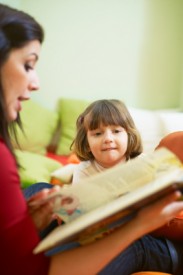
3 reasons you should read to your children
You probably already know that you should read to your children, but do you know why? Here are three important reasons to not only read aloud with your child, but also to make it a shared activity:
- Reading exposes your child to rich language and diverse content. Book language uses a larger vocabulary and more complex grammatical structures than the short, one-way communication we tend to use in feeding and caring for our children [i] . Books allow parents to expand the language environment as they become their children’s first and most important teachers. They help parents to immerse their children in rich and varied language. Books of narrative fiction spark children’s imagination as they entertain and inform them about their emotions. Books of informational non-fiction answer questions, providing concepts and knowledge that are the cornerstones of science and math. Both types are important and all of their benefits can be realized with books in any language. Parents should feel empowered to read aloud in Spanish, Chinese, or whatever their native language.
- Reading with your children helps prepare their minds to succeed in school. The benefits of shared reading know no age limits. Babies are soothed by their parents’ voices; school children reading to parents can show their new accomplishments or seek their parents’ help. Books for toddlers can help children get ready to learn to read, as we are proving in two school readiness programs, ‘HABLA’ and ‘Jumpstart,’ that I brought to the University of California, Irvine. I recommend books that provide nursery rhymes, songs and verse as they help children learn to appreciate the sounds within words. Children are used to listening to language for its meaning, but reading demands that they also pay attention to the sounds of language. Hearing words in terms of syllables, consonants and vowels encourages phoneme awareness, which is the first step towards reading phonetically. Nursery rhymes and songs leap from the page when parents remember them from their own childhood and make them a part of family life. When said in English or Spanish, traditional nursery rhymes and songs help attune children to what the alphabet is all about. [ii]
- Reading with your child can enrich family ties and intimacy. Its virtues are strongest when parents read ‘dialogically’ by taking the book as an opportunity to enjoy a conversation. Reading together is family time; it is fun time, cuddle time, a time to share your passions, perspective, and your values but also a time to listen. It creates a time for children to express themselves as well as an opportunity for parents to show their willingness to listen. When we build a conversation around a book we encourage our children to communicate with us. [iii]
[i] Research has shown that parents pressed for time and patience fall back on short speech like ‘wash your hands’ “Bedtime!’, ‘stop it?’ or ‘Because I said so.’ This is particularly true of parents who are educationally and economically disadvantaged. For a summary of a study about the importance of providing rich language to children, and evidence about the profound language deficit that surrounds children living in poverty see Hart and Risely, 1995, summarized here.
[ii] To learn more about teaching children to read as summarized in the National Reading Panel report on phonics as the favored method of instruction, see: Teaching Children to Read by Dr. Martha Burns. For information about UCI’s HABLA program, ands it work to increase parent child literacy activities in Spanish speaking homes, click here.
For information about Jumpstart and its goals, see the official Jumpstart website and https://sites.google.com/site/jumpstartatuci/. For some excellent points about informational text, see Drs. R and H. Yopp’s Preview-Predict-Confirm: Thinking About the Language and Content of Informational Text.
[iii] For more information about dialogic reading, see Dr. G. Whitehurst’s Dialogic Reading: An Effective Way to Read to Preschoolers.
Related Reading:
5 Things Every Parent and Educator Should Know About Early Childhood Brian Development

